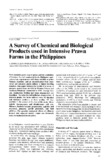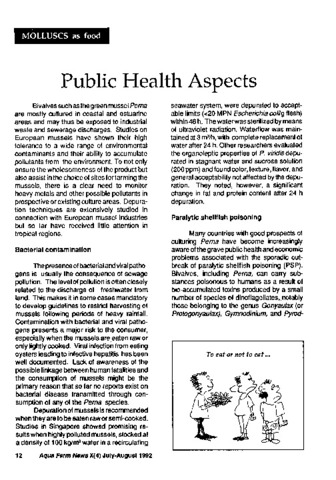Accumulation and excretion of metal granules in the prawn, Penaeus monodon, exposed to water-borne copper, lead, iron and calcium
| dc.contributor.author | Vogt, Günter | |
| dc.contributor.author | Quinitio, Emilia T. | |
| dc.date.accessioned | 2013-02-21T09:00:09Z | |
| dc.date.available | 2013-02-21T09:00:09Z | |
| dc.date.issued | 1994 | |
| dc.identifier.citation | Vogt, G., & Quinitio, E. T. (1994). Accumulation and excretion of metal granules in the prawn, Penaeus monodon, exposed to water-borne copper, lead, iron and calcium. Aquatic Toxicology, 28(3–4), 223–241. | en |
| dc.identifier.issn | 0166-445X | |
| dc.identifier.uri | http://hdl.handle.net/10862/1466 | |
| dc.description.abstract | Juveniles of the giant tiger prawn, Penaeus monodon, were exposed for 10 days to 1 mg/l copper, lead, iron or calcium in order to investigate the formation and accumulation of metal granules in major soft tissues as well as their excretion from the body. Metal deposition was investigated by histochemistry and electron microscopy in the hepatopancreas and surrounding organs and tissues like the stomach, midgut, anterior midgut caecum, thoracal antennal gland extensions, haematopoietic tissue, and interspersed musculature, connective tissue and pigment tissue. The abundance of metal granules varied greatly between the metals and the tissues. Iron and calcium deposits were found in none of the tissues investigated. Copper granules were accumulated in high quantity in the hepatopancreas tubules, were scarce in the antechamber of the hepatopancreas, the anterior midgut and the anterior midgut caecum, and were lacking in the other tissues. The amount and size of copper granules increased along the hepatopancreas tubules in accordance with the cells' age. The granules were released by discharge of senescent hepatopancreas cells in the antechamber region and were added to the faeces. Lead granules were primarily found in the thoracal extensions of the antennal gland. In the hepatopancreas they occurred only in very small quantities, and in the other organs and tissues they were absent. In the antennal gland, the lead granules were individually discharged into the gland lumen by apocrine secretion and excreted with the urine. The observed ability of Penaeus monodon to detoxify and remove metals like copper and lead by granule formation and excretion and to prevent other metals like iron from entrance into major soft tissues corroborate that decapods are no suitable organisms for a long-term biomonitoring of heavy metal pollution. | en |
| dc.language.iso | en | en |
| dc.publisher | Elsevier | en |
| dc.subject | prawns and shrimps | en |
| dc.subject | Penaeus monodon | en |
| dc.title | Accumulation and excretion of metal granules in the prawn, Penaeus monodon, exposed to water-borne copper, lead, iron and calcium | en |
| dc.type | Article | en |
| dc.identifier.doi | 10.1016/0166-445X(94)90035-3 | |
| dc.citation.volume | 28 | |
| dc.citation.issue | 3-4 | |
| dc.citation.spage | 223 | |
| dc.citation.epage | 241 | |
| dc.citation.journalTitle | Aquatic Toxicology | en |
| seafdecaqd.library.callnumber | VF SJ 0477 | |
| seafdecaqd.databank.controlnumber | 1994-19 | |
| dc.subject.asfa | bioaccumulation | en |
| dc.subject.asfa | calcium | en |
| dc.subject.asfa | copper | en |
| dc.subject.asfa | excretion | en |
| dc.subject.asfa | heavy metals | en |
| dc.subject.asfa | histochemistry | en |
| dc.subject.asfa | iron | en |
| dc.subject.asfa | lead | en |
| dc.subject.asfa | metals | en |
| dc.subject.asfa | pollution monitoring | en |
| dc.subject.asfa | water pollution | en |
| dc.subject.asfa | indicator species | en |
| dc.subject.asfa | pollution effects | en |
| dc.subject.scientificName | Penaeus monodon | en |
Files in this item
| Files | Size | Format | View |
|---|---|---|---|
|
There are no files associated with this item. |
|||
This item appears in the following Collection(s)
-
Journal Articles [1256]
These papers were contributed by Department staff to various national and international journals.




